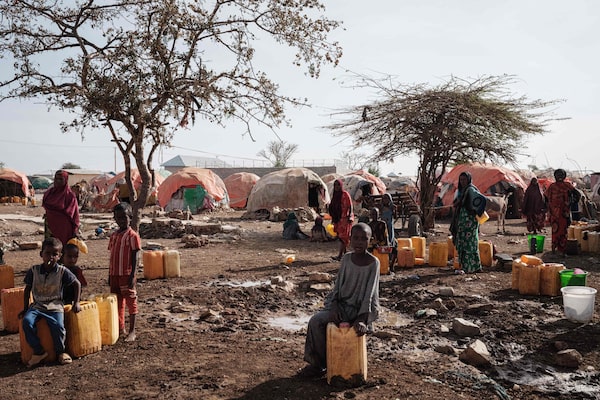
People wait for water at an IDP camp in Baidoa, Somalia, on Feb. 13, 2022.YASUYOSHI CHIBA/AFP/Getty Images
Ethiopian relief workers are finding disturbing evidence of death and hunger as they reach drought-stricken villages in Oromia, one of many regions in the Horn of Africa where humanitarian operations are increasingly hindered by war and insurgency.
More than 20 million people, mostly in Somalia and Ethiopia, are in urgent need of aid after four consecutive seasons of failed rains in the worst drought in 40 years, United Nations agencies estimate. Famine is already beginning to emerge in some Somali regions, and meteorologists are warning of a fifth season without rains later this year.
In a village in eastern Oromia, volunteer aid workers found a woman named Nujuma Odaa collecting muddy brown water from a pothole on a dirt road. A nearby river had dried up, and now she was walking up to seven hours to fetch water from remote areas. Eight of her 10 cows had died in recent days, she told the workers.
The region is normally fertile enough to produce cash crops for export, but now the pastures and livestock are dying. Aid workers from an Oromo group, Caayaa Humanitarian Organization, met community leaders who described how starvation has killed many villagers and left others fainting from hunger.
Relief agencies have found it difficult to reach drought-stricken regions in Ethiopia and Somalia where armed militias are battling government forces. Without aid, many families are forced to migrate.
More than a million people have abandoned their homes in Somalia because of the failed rains, while more than 160,000 people in southern Oromia have been displaced by drought, according to UN estimates.
“The dead people are sometimes left without a grave because there’s nobody with enough strength to dig one,” said Obsaa Malicha, a 40-year-old market trader from Bale zone in southeastern Oromia who left his home in late August.
In a telephone interview, he told The Globe and Mail how one village woman had died of hunger as her infant child was trying to nurse from her. The cattle of the local farmers are dying every day, he said.
Across the Horn of Africa, a devastating drought threatens starvation and famine for millions
From floods in South Africa to drought in Somalia, climate change is devastating millions of lives
Others gave similar accounts. “I lost all of my 35 cows, and I’m not the only one,” said Boru Guyo, a farmer in Borena zone in southern Oromia who left his village when the rains failed.
“I haven’t seen government aid in any form,” he told The Globe. “Women and old people are in the worst situation – they can’t walk long distances and some suffer from diarrhea. Some women support themselves by selling charcoal on the main road, but they have to travel long distances, which is dangerous.”
By the end of April, an estimated 1.3 million livestock had died from the drought in Oromia, while another two million were too weak to move, local officials told Ethiopian media at the time. The crisis has only worsened since then.
In Somalia, there are signs of famine in two areas in the south-central region of the country, and millions of people are facing “extreme levels of acute hunger,” according to a report by UN agencies and other humanitarian groups last week.
“Somalia has reached a tipping point,” the report said. “Starvation and death are likely already occurring.”
While famine has not been officially declared in Somalia yet, this could be a mere technicality. In its last famine, in 2011, more than half of the estimated 250,000 deaths took place before a formal declaration was made.
In total, more than seven million people in Somalia need urgent aid because of the drought, the UN says. The situation is worse than it was in 2011, according to Martin Griffiths, the UN emergencies chief. He said he was “shocked to my core” by the pain and suffering that he witnessed in Somalia in a visit this month.
“Famine is at the door,” he told journalists last week. “One and a half million children across Somalia will face acute malnutrition by October if we remain on the current course.”
In Ethiopia, about eight million people need urgent aid because of the drought. Insurgencies and internal wars are hampering the delivery of aid to several drought-afflicted regions of Ethiopia, including parts of the Oromia, Tigray, Afar and Somali regions.
“I met people who travelled long distances in search of food and water sources,” said Mamadou Dian Balde, the Ethiopia representative of the UN refugee agency, UNHCR, after a visit to the country’s Somali region this month.
“Families with young children travelled two months on foot with their few remaining livestock,” he told a media briefing. “Their donkeys died during their travel due to lack of food and water, so they had to carry their own dwindling belongings.”
The aid effort is also complicated by sharply rising food and fuel prices, severe funding shortages at the major relief agencies, and restrictions imposed by the national government in insurgent strongholds such as Oromia and Tigray.
Many people are migrating from drought-afflicted areas to larger towns or cities. “Our existence is at risk,” said Jibril Intala, a shopkeeper in southern Oromia who plans to move northward.
“We’re experiencing high temperatures, and we’re afraid that the water in the ground will disappear sooner than we think,” he told The Globe. “It looks like there’s no end to this drought.”
 Geoffrey York
Geoffrey York